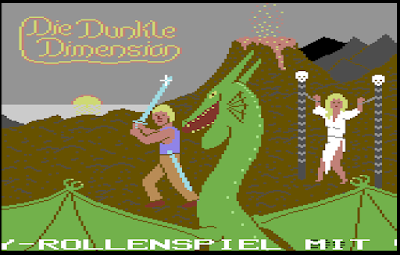From The CRPG Addict
Die Dunkle Dimension
“The Dark Dimension”
Germany
German Design Group (developer and publisher)
Released in 1989 for Commodore 64
Date Started: 29 August 2018
When I decided my master list would include foreign games, as long as they were in a language I could easily type into a translator, I expected that I’d be translating a two-paragraph backstory, a one-screen ending, and a bunch of repetitive stuff like “you miss the skeleton!” in between. I wasn’t counting on games that were so text-heavy, like Antares, Die Drachen von Laas, or Nippon. Now here comes another one, Die Dunkle Dimension (“The Dark Dimension”), in which I accomplished over four hours what would have taken me 35 minutes in an English title.
Dunkle is a German Ultima IV clone, and unlike the author of most clones, the developer here did a good job retaining most of what makes Ultima IV so special, including the keyword-based dialogue system, the sense of exploring a large world, and the tactical combat screen. It lacks the virtue system, of course, and you control only one party member throughout the game. Still, it’s a better clone than most.
The setup even sounds like Ultima IV in its beginning: You, a person in the “real world,” decide to take a walk on a warm summer day. You soon stumble upon a crystalline shard in the grass. Picking it up, you quickly learn that it’s some kind of portkey, and within a few minutes, you’re warped through time and space to another dimension. You splash down into a lake and swim to shore, just avoiding the jaws of a giant serpent. At first, you think you’re in the past looking at a dinosaur, but then the dinosaur breathes fire, and you realize you’re in another world. (Although: are we sure that dinosaurs didn’t breathe fire? That would be pretty rad.) You set out to find out where you are and how to get home.
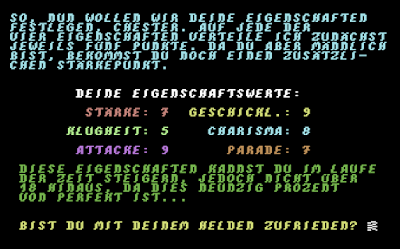 |
| Character creation sure has a lot of text to translate. |
Character creation is a simple and unnecessarily wordy process of specifying a name and then identifying a primary attribute from among four choices: strength, skill, wisdom, and charisma (I chose strength). You get to specify a difficulty level (I chose “medium”), and whether you favor attacking or defense (attacking). The game then determines your final attribute scores.
Gameplay begins where the story left off: on the shores of a lake with a serpent lurking nearby. You have to get away from the shore before he closes and attacks.
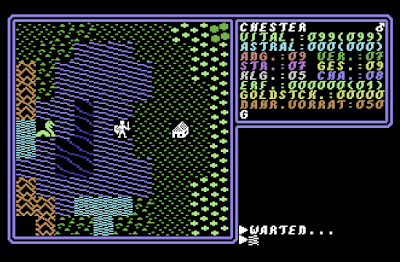 |
| Arriving in a new world. |
The interface is much like an Ultima title. Movement is with the bracket-semicolon-apostrophe-slash cluster (on a PC keyboard anyway; their analogues on a C64 are a little different), and actions are performed with single letters, such as (A)ttack, (K)ommunicate, (I)nventory, and (R)eady armor. The specific list varies a little depending on whether you’re outside, inside, or in combat. In any event, it’s relatively easy to master.
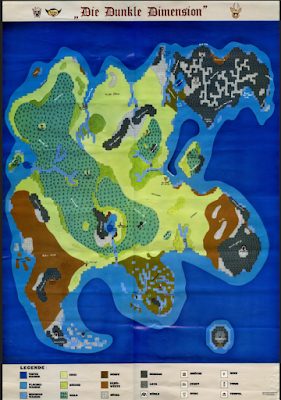 |
| The game came with a map. I believe the starting area is at the lake slightly southwest of center. |
Near the starting point is a cottage, so naturally I entered it. It turned out to be the home of a druid named Cerfak. Conversation with NPCs proceeds exactly as in Ultima IV except that you only type the first four letters of your keyword. All NPCs respond to NAME (same in both languages), GESUndheit (health), and BERUf (occupation). The rest of their responses are from keywords that they feed you or that other NPCs tell you to ask them. Occasionally, they ask you something that requires a (J)a or (N)ein response.
Cerfak was extremely wordy, and he left me terrified that all NPCs would have as much to say. Fortunately, that isn’t the case, because it took me almost an hour just to transcribe his conversation. It was important, because it includes a lot about the backstory and quest.
Name: I am Cerfak
Health: I am exhausted. Are you OK?
Yes: I’m happy for you
Job: I am a druid.
Druid: We druids are wise old magicians, but closer to nature than sorcerers. We see, we heal, and we help.
See: I see how evil conquers our world.
Heal: let me heal you (heals me)
Help: Ask what you want to know. I know a lot.
World: Evil has destroyed the balance of our world.
Balance: Are you from another world?
Yes: Once upon a time, our world was beautiful and bright. The people lived in peace and were happy. But the Evil One brought eternal darkness over us, and the creatures of darkness came out of their holes and overflowed the land. The sun will never rise again, because the crystal is broken.
Crystal: The Crystal of Light that kept the balance of our world. Carried by fire and air, it floats above the lava of the great volcano. But the Evil One struck with all its cruel power, and the crystal shattered. A splinter broke off. The crystal turned black. With it went the sun [thus explaining the game’s name]. The splinter broke out of the upper right corner of the crystal. Remember this point! The Evil One built an impregnable fortress in the form of a huge skull around the crystal. There he lurks and sends out doom. The splinter was cast into another dimension. When you touched it, a spell broke and the splinter and you were teleported here. Do you have the splinter?
No: (At least it’s not listed in my inventory.) Go and find it; otherwise our world is lost forever. Go northeast. There you will come to the castle of the king. There, they will help you.
Splinter: The crystal and the splinter must be united!
Bye: My prayers go with you.
 |
| The druid has a lot to say. |
The bit about the crystal, shard, lava, and mountain seem to be influenced by
The Dark Eye tabletop RPG published by Schmidt Spiele in 1984 (on which the later CRPG
Realms of Arkania was based). I don’t know the game well enough to determine if the developer of
Dunkle took any other inspiration.
The character starts with no weapons or armor, and there’s no obvious place nearby to obtain any. It’s not long before robbers, zombies, forest demons, and goblins come wandering out of the nearby woods and start attacking. Fortunately, the character is capable of beating most of these combatants to death with his bare hands. He takes a large hit point loss doing so, but the druid heals for free.
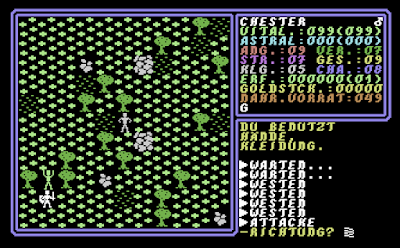 |
| Attacking a forest demon in forested terrain. A zombie approaches. |
Combat is again much like Ultima IV. When it begins, the action transitions to a tactical map based on the terrain you were standing on. You can use environmental obstacles to block and funnel enemies. You and enemies exchange turns, and during your turn you can attack, cast a spell, or switch weapons (I naturally have no spells or weapons yet). When hit, enemies progress from barely scratched (kaum angekratzt) to lightly wounded (leicht verletzt), wounded (verwundet), seriously injured (schwer verletzt), fleeing (auf der flucht), and then death. If an enemy successfully flees (which happens to my weaponless character most of the time), you get his gold but no experience points. If you flee, you lose some experience points. Animals provide no experience, which echoes Ultima IV‘s system by which it was unvirtuous to kill them.
I made some money hanging around the druid’s hut, but I noticed my food depleting (you start with 50 rations) and I figured I’d better stake out for a town or the king’s castle, as recommended by Cerfak. It took me a few false starts in which I was killed by an accumulation of combats on the way. Fortunately, you can save anywhere outdoors and reload.
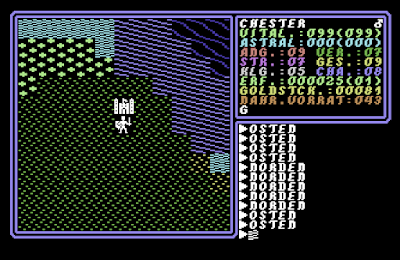 |
| Arriving at the castle. |
The king’s castle was a small, one-level structure with about a dozen NPCs. Collectively, they had only about as much text as Cerfak by himself, but it still took a long time to translate. Of course, there was a Chuckles analogue (calling himself a “harlequin”) waiting for me in the courtyard. This was his joke:
Q: Do you know the difference between a king and a hippopotamus?
A: The hippopotamus bathes more often!
I’m not sure how that’s supposed to be any kind of an insult considering a hippopotamus basically lives in water. I mean, you could bathe twice a day and a hippo would probably still bathe more often than you.
 |
| Chuckles somehow has the power to annoy me across universes. |
Anyway, among the NPCs the king and queen had the most dialogue. King Casiodorus said he’d heard of my exploits even though I haven’t done much. After a quick pause, he encouraged me to come back when I had more experience–clearly, I go to him to level up. Between him and the distraught queen, they related that there’s a terrible dragon (lindwurm) who lives in the mountains to the east. Twice a year, always at solstice, he gets hungry for human flesh. To avoid him razing the countryside, the nation made a deal with him to supply him with virgins twice a year, their names drawn by lottery from all the eligible young women in the kingdom. Unfortunately, Princess Sheila’s name came up in the last drawing and she’ll soon have to be sacrificed. The king implored me to find a way to defeat the dragon. Not only is this the plot of 1981’s Dragonslayer (in which Peter MacNicol is weirdly miscast as the hero), but the king’s name is taken from that film. The forthcoming rescue seems to be what’s depicted on the title screen.
 |
| The king introduces himself. |
Torquill, the king’s sheriff, also told me to ask the king about a thieving band that lives in a lair called Mubrak. The king is eager to wipe them out. So I left the castle with two quests which may be side quests or somehow related to the main quest.
Other NPCs included Chancellor Helmut Kohl, who had nothing to say; Dakteon the bard, who told me that no one can pronounce the name of the Evil One without burning alive, but that I’d somehow need to do it; Antonius the priest, who admitted that he doesn’t believe in God, but “you have to make a living somehow”; and Theodorus the geographer, who asked if I wanted maps of all the game’s dungeons and towns and, when I said yes, told me to send money to the German Design Group and gave me the address.
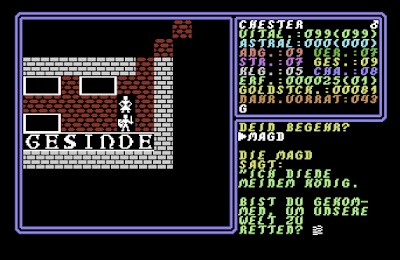 |
| A random maid asks if I’m there to save the world. |
In a corner, a swordmaster named Ator (from the Italian series of Conan-inspired films) said he could train me when I was more experienced. When you level up, you must get the ability to raise your attributes.
Unfortunately, there was no place to buy weapons or armor in the castle, so I left unsure what to do next. I ultimately made my way back to the familiar territory of the druid’s hut, and I’ll have to explore outward from there.
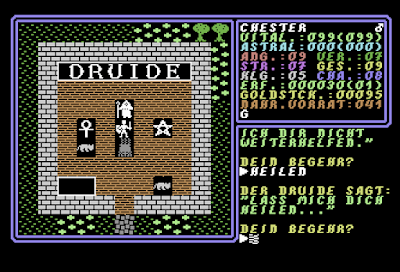 |
| The druid heals me for free as I slowly build my gold and experience around his hut. |
Other notes:
- Magic, which I haven’t had any chance to investigate yet, is apparently divided into white magic (healing and protection spells) and black magic (damage spells), a division that we’ll see later in the German Dragonflight (1990). Casting them requires reagents, just like Ultima IV.
- Also making an appearance from Ultima IV are bridge trolls (they have a random chance of attacking when you cross bridges) and patches of swamp that poison the character.
 |
| Bridge trolls are a little too tough for an unarmed character. |
- Enemies can move and attack on the diagonal but you can’t. This makes it impossible to outrun enemies.
- From the manual’s descriptions, horses, ships, and aircraft are due to make appearances.
- The king’s castle has something you don’t find in most RPGs: bathrooms.
 |
| There’s even a toilet paper roll holder and a toilet brush. |
The primary author of Die Dunkle Dimension seems to be one Hendrik Belitz, who went by the pseudonyms “Silent Shadow” and “The Dark One.” Belitz had a web site dedicated to the game as recently as a few years ago, but he seems to have lost the domain. I was able to retrieve it from the Internet Archive and get the files that were offered on it, including the game manual and map. Scanning the site and the documentation, I found it more than a little irksome that the author didn’t provide any credit to Ultima, from which he’d clearly taken so many of the game’s concepts. I never criticize clones for being clones, but I sure do criticize them for not acknowledging that they’re clones. We’ll talk more about the author, company, and legacy of the game in the final entry.
I’m nowhere near having translated the entire manual yet; I’m just consulting bits and pieces as I need it. This one seems like it’s going to be slow-going but perhaps enjoyable in its own way.
Original URL: http://crpgaddict.blogspot.com/2018/09/game-303-die-dunkle-dimension-1989.html













